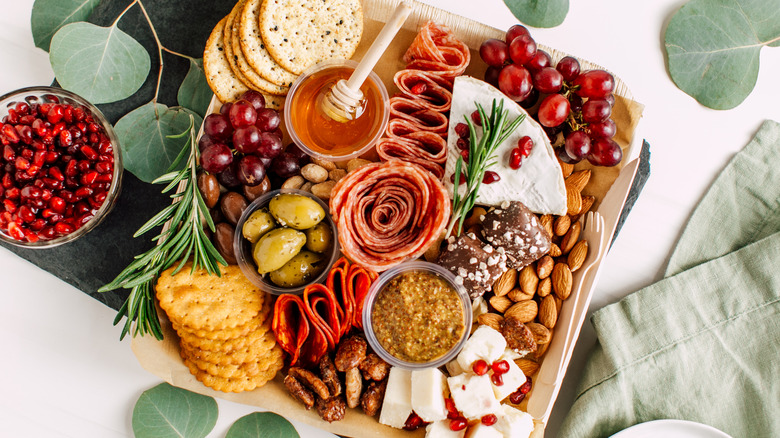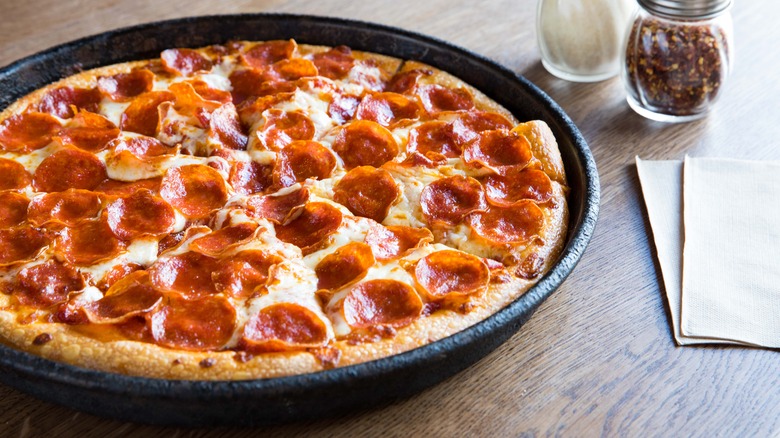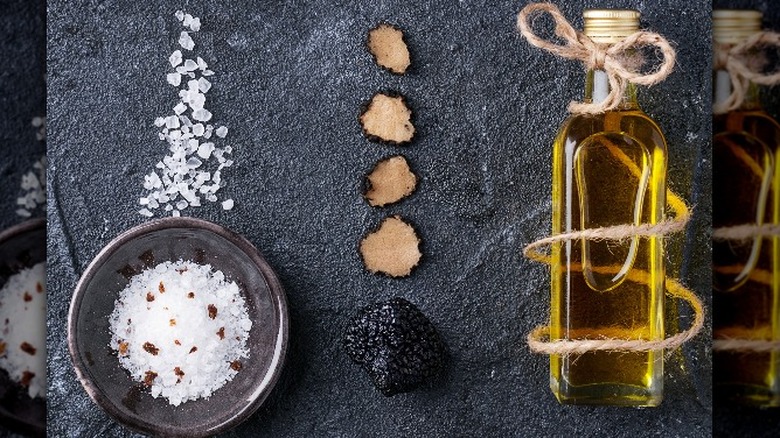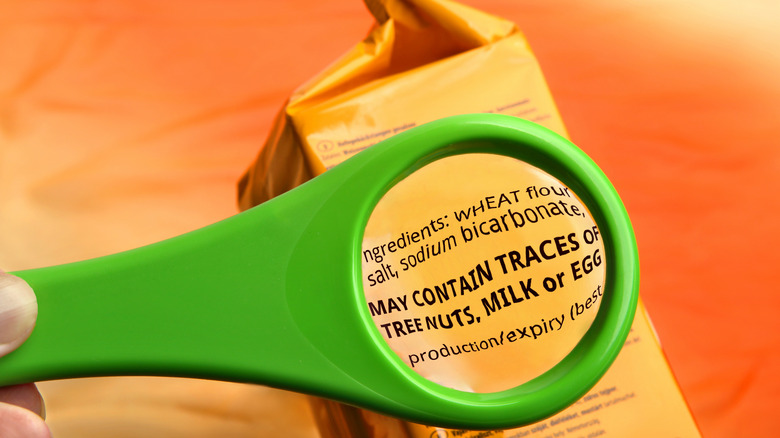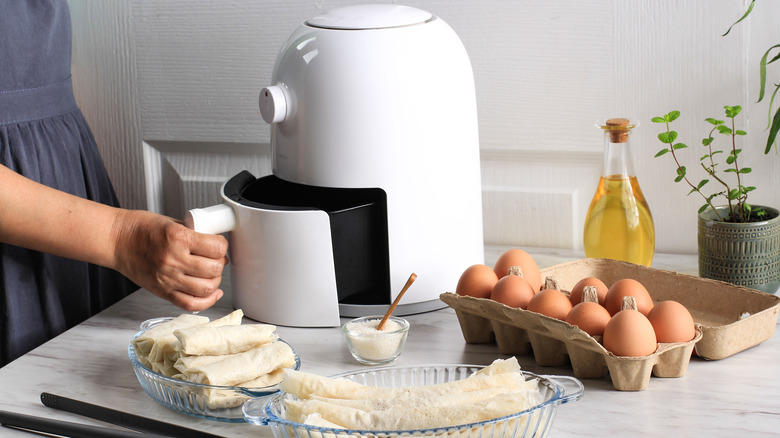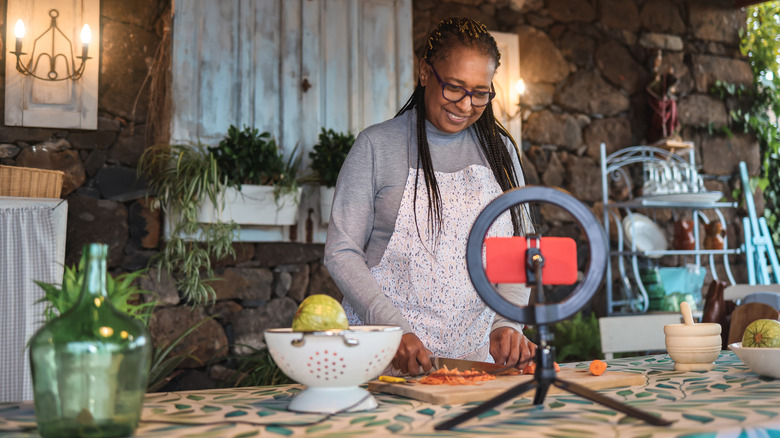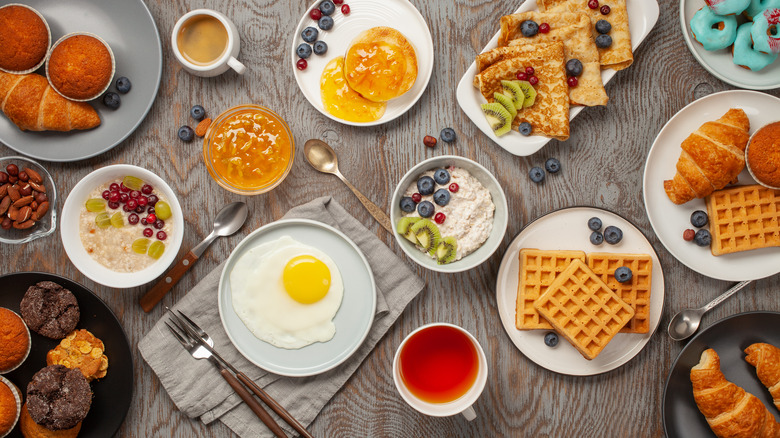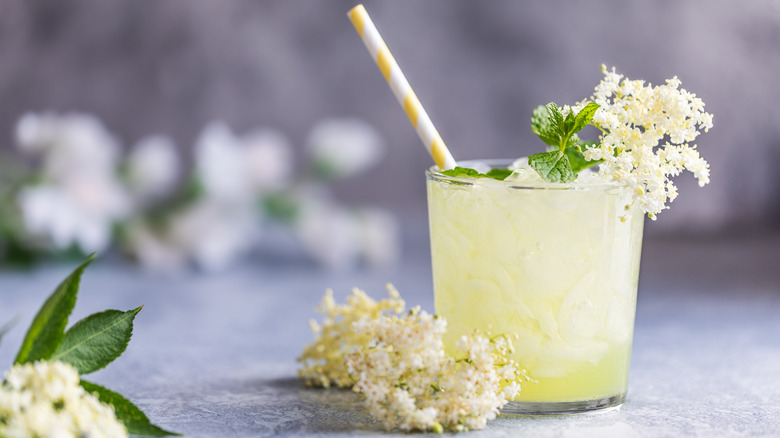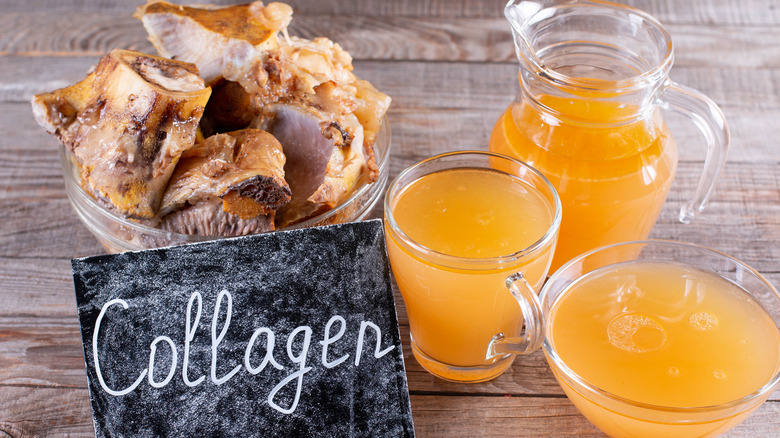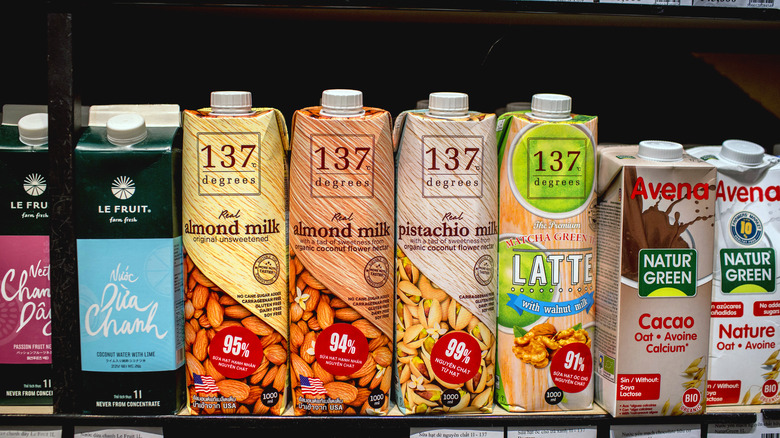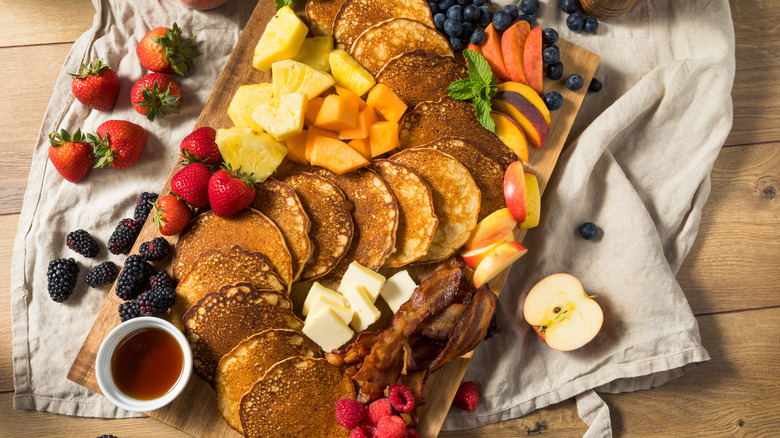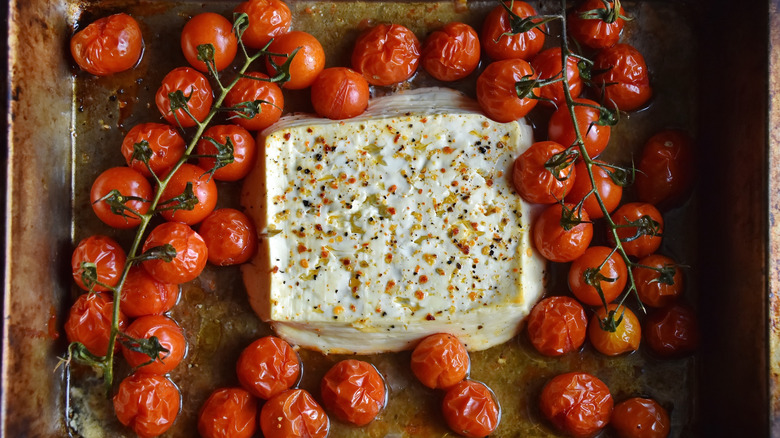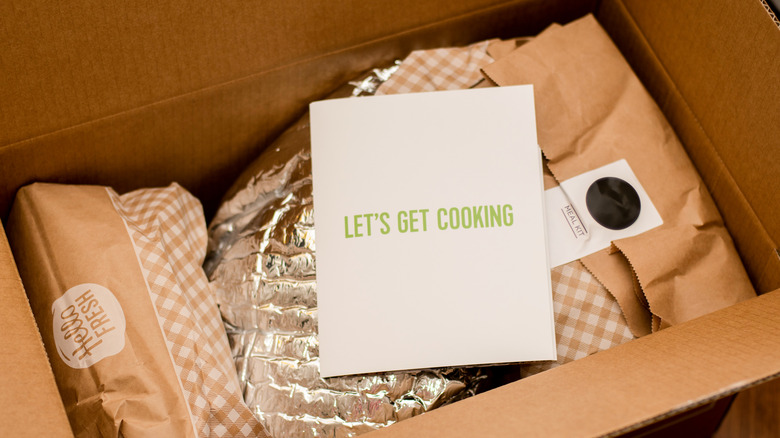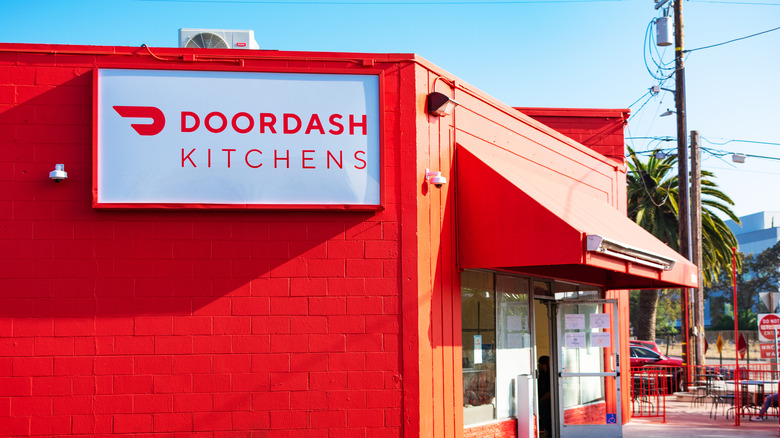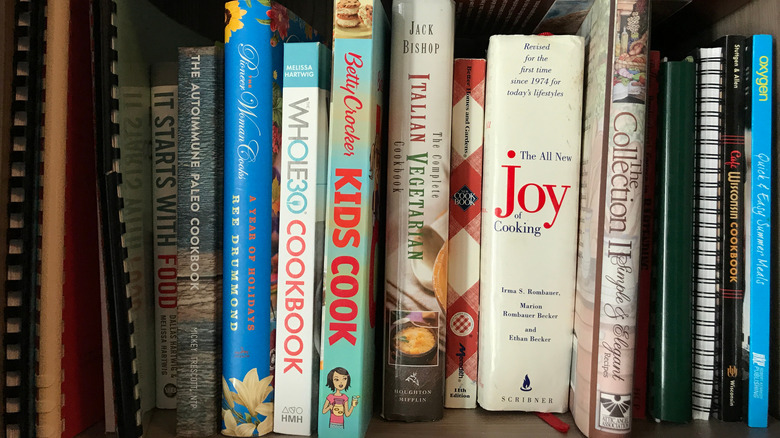The Best And Worst Food Trends Of 2021
From coronavirus variants to supply chain issues, vaccines and the ability to hug our loved ones again, our rapidly evolving world saw a host of new challenges and achievements in 2021. All of 2021's many changes affected the way we walk through the world, including how we interact with the foodscape. The food trends of this year are, like any year, were reflective of how we perceive the current moment. It is likely that we will look back upon them and think of how we felt during these difficult times, as well as wondering, "Did I really try to air fry that?"
Let's all take a moment to remember that just because something has a moment in history this does not make it good — case in point, TikTok's pasta chips. This is not to say that all of this year's food phenomenons are bad. Plenty of great ones came around, like the increased availability of allergen-friendly foods, plant-based proteins, and non-alcoholic beverages, all of which made life easier for a variety of different people. We certainly took the good with the bad on this trip around the sun, and the food trends this year speak to that variety.
From ghost kitchens to cookbooks sales, functional foods, and the "board" movement, here are the best and worst food trends from this rollercoaster of a year.
Best: Comfort food
Comfort food saw a massive resurgence during the early stages of the pandemic. Whether due to nostalgia for better times or cost-cutting practices, Americans increasingly turned to familiar favorites to ease their minds. Pizza consumption went up 55% in 2020, hamburgers by 48%, ice cream by 46%, and French fries by 45%, according to PR Newswire.
While our love of comfort food continued into 2021, it looks a bit different this year. Namely, the definition comfort food this time around is far broader. Gone are the days of just pizza and hamburgers, as Millennials and Gen Zers have broader palettes than the average Boomer or Gen Xer. Since the population during their formative years was the most diverse it's ever been, younger generations include foods of many cultures in their comfort cannon, like tacos and ramen. Increased TikTok usage has added to the prevalence of these foods in 2021, as Zoomers are inspired by creators sharing dishes from their various backgrounds. This young population is also the driving force behind alternative comfort foods, which feature plant-based fixings or healthier ingredients, and are increasingly represented on 2021 menus at even the largest chains.
Best: Kicking basics up a notch
As Americans re-familiarized themselves with the kitchen, we began to look for ways to spice things up -– literally. If 2020 was all about ruts and habits, 2021 was about building upon our foundations and using time at home to lean into the things we love. Enter: your basics, but better. Think innovative jam varieties, higher quality spice blends, and oils with a twist.
Elevated basics make life a little easier by including more spices and flavor from the get-go. After all, you could spend your week hunting down the perfect truffle oil for your pasta sauce, or you could just grab a jar of Truff Black Truffle Pomodoro. Infused oils are wonderful for adding interest to plain dishes, but they take time to steep –- why not just buy a bottle of herbs de provence olive oil? This trend is a great way for less experienced cooks to produce five-star meals, plus, it makes busy weekday meals a little more flavorful. Elevated basics give even practiced chefs a new project, challenging them to incorporate unique and interesting flavors into their dishes. This is a 2021 trend we are happy to keep around.
Best: Better ingredients in the products we love
Not only have basics gotten more interesting, but they've also become better for you. A cultural shift towards health and wellness has prompted companies to rethink their ingredient labels, using less processed and more recognizable ingredients. Although the familiar refrain, "if you can't pronounce it, don't eat it," doesn't exactly hold up to scrutiny, it's a good starting point towards a more healthful and earth-friendly diet –- and one consumers have latched onto. The natural food colors and flavors market has a calculated annual growth rate of 5.4% for the early 2020s, and is largely guided by consumers' want for products with "clean" labels.
A very important byproduct of this trend is better flavor payoff: higher quality, less processed ingredients often taste better and more vibrant than their cheaper counterparts. Since this trend is both good for you and your tastebuds, we rank it as one of the best of 2021.
Worst: Air fryer overuse
2021 was truly the year of the air fryer. In an era where people are cooking at home more often and ease is a top priority, the set-it-and-forget-it nature of these little machines is incredibly appealing. Wellness is also very trendy, and the prospect of getting crispy-fried food without deep-frying in oil has consumers excited.
However, while air fryers are great for a lot of things, it seems we got a little confused somewhere along the way. Say it with me people: not everything belongs in the air fryer. Seriously! Air fried gnocchi? Yes, the crispiness the air fryer provides is a lovely addition to certain dishes. But do we need everything be crunchy? Differences in texture throughout a meal provide for a more interesting eating experience, and are even highly valued in certain cuisines. Honestly, gnocchi is supposed to be soft and pillowy, and if it ain't broke, don't fix it.
Plus, certain foods just plain don't work in an air fryer. Since it is effectively a tiny convection oven, the extra crisp comes from powerful fans that rapidly circulate air around your food. They're also what dry out your broccoli, cause your nicely laid shredded cheese to tornado, and overcook the inside of your hamburger. Air fryers are best when treated like any other kitchen appliance and only used for what they're made to do. Don't forget, people — you also have a regular oven.
Best: Food accounts that feel within reach
As attitudes change and culture shifts, our relationship to social media looks very different than it has in years past. For years, the standard with food accounts has been excess and indulgence: videos of impossibly large milkshakes, burgers overflowing with toppings, and expensive dishes at dimly lit restaurants. But, as American culture has shifted away from transparent displays of wealth and opulence, the most famous food posts have something in common. They increasingly take place in home kitchens, sometimes with creators in sweats, often using the microwave.
While much of this content is still aspirational in nature, it feels far more accessible than the influencers of yore. The allure is not that the food is out of reach, but rather that you could make it if you wanted to (the included, easy-to-follow instructions make sure of that). Plus, these lifestyles don't require thousands of spare dollars or a house in LA. All it takes to live the life of a 2021 food star is a run to Trader Joe's, a positive attitude, and maybe an air fryer.
We rank this trend as one of the best of the year. Creators who look like us and feel like friends are, in our humble opinion, far better than untouchable Insta-celebs. The wholesome and nourishing recipes they make are a great thing to strive for, plus, their clear directions make skill-building in the kitchen easier than ever. What's not to love?
Best: Big weekday breakfasts
Spending more time in the house and an uptick in home cooking has led to increasingly decadent breakfasts, even during the weekdays. Microwavable breakfast sandwiches have given way to bacon, eggs, and pancakes with all the fixings as we continue on this slower pace of life. In fact, Americans are eating more breakfast during the pandemic than before, with 24% reporting eating more breakfast foods than in normal times. While some of this breakfast-food-eating happens outside of normal breakfast hours, the increased free time reported in 52% of Americans' schedules has caused them to spend more time creating elaborate morning meals.
This trend is reflected in products available on the market, including decadent pancake mix flavors and fancier grab-and-go options. Take, for example, the Birch Benders Organic Confetti Pancake and Waffle Mix. The mix was launched in 2021 after an "increased demand for flavor innovation" in the breakfast world, and features, "the most eye-catching celebratory packaging, flavors and ingredients after a year of missed celebrations." It doesn't get more 2021 than that! Food this year is a celebration, and we're loving this era's ode to breakfast foods.
Best: Low- and non-alcoholic beverages
Although alcohol sales skyrocketed in the first year of the pandemic, 2021 saw a shift in a surprising new direction. Total sales of non-alcoholic beverages went up 33% within the last year, totaling $331 million, while online sales of non- and low-alcoholic beverages more than tripled. New York even got its first non-alcoholic bottle shop in November of 2020, with Los Angeles following suit less than a year later. Here customers can browse zero-proof spirits, wine alternatives, and a variety of mixers fit for any fancy bar.
They may seem strange to alcohol lovers (booze without the booze? Where's the fun in that?), but sober folks, pregnant people, and those with health issues love nonalcoholic beverages, just to name a few. These alcohol alternatives provide for a healthful evening ritual or something to sip on at the bar, but won't be detrimental to their health or sobriety. Even people who drink regular-proof alcohol have come to enjoy spirit alternatives and low-proof drinks. This growing consumer group is called the "sober curious," and is mainly made up of young people and the health-conscious.
In a period where health is at the forefront of everyone's mind, it makes sense that consumers have reexamined our relationship to alcohol and sought out different options. We say cheers to these new beverages and the lifestyle options they provide.
Worst: Every food being functional
Functional foods claim to provide additional health benefits beyond the normal perks of a healthy diet. These benefits can include better sleep quality, a boosted mood, increased immunity, or even better brain function. Because of overall trends towards health and wellness (especially during such an uncertain period for global health) the functional food category has been steadily growing during 2021. Seventy percent of consumers report using functional products this year.
While eating certain foods to boost your mind and body is not inherently a bad thing, these functional foods are often marketed with the impression that everything you put in your body has to serve a purpose. From collagen cookie dough to charcoal and mushroom lemonade, companies are finding ways to pack super-ingredients into even the most classic junky snack foods. The thing is, everything you eat is already doing something for your body, whether providing you with micronutrients, a sense of comfort, or just plain calories. Attempting to make every food you eat "functional" can lead to restriction of "normal" foods and cause disordered eating patterns. Such behaviors in turn can cause mental and physical health effects, not to mention an expensive and difficult to maintain lifestyle.
Like with many diet or health food trends, functional foods are great in moderation, but they needn't make up the entirety of your diet. In other words, your chocolate cake can just be chocolate cake, and there's no reason to feel bad about that.
Best: More available alternatives
From plant-based proteins to flour substitutes and new milks, alternative food sales have soared in 2021. Plant-based products are one of the largest players in this category, with an expected sales growth of 500% by 2030. A 2021 survey by YouGov found 40% of people aged 18-44 consume a plant-based alternative at least once a month, demonstrating how consumers are driving this trend forward. Additionally, alternatives these days are not only limited to indie brands. Large corporations like Tyson and Nestle launched plant-based products this year, hoping to establish a foothold during the early stages of this emerging market.
Other alternative products, like flours and sugars, have also seen growth this year. In fact, despite facing an initial boon from wheat flour stockpiling, the alternative flour market has continued on an upward trajectory even after wheat supply chains caught up to demand. This year, oat flour sales grew by 103%, while almond increased by 110%.
These options make it easier for people with allergies or dietary restrictions to live their lives, and for that, we say keep 'em comin'! They also contribute to greener lifestyles as plant-based alternatives typically have far lower footprints than their animal counterparts, which is another great benefit.
Worst: Making everything a board
We get it, you're bored at home (no pun intended). It's not enough anymore to simply cook and plate, you want a project, something to fill up your free time. Well, congratulations, because you've certainly found such a task in the board trend. Inspired by charcuterie boards, the internet has taken to these deconstructed meals which are extravagantly plated and aesthetically organized. From build-your-own sundae bars to mile-high stacks of deli meats, it seems anything can be a "board" these days as long as it rests on a plank of wood.
While there are certainly some good examples of this trend, breakfastini boards and barkcuterie (that's charcuterie for dogs) prove that it's gone a little too far. Call us haters, but something about it just feels so unnecessary –- there's a thin line between having fun with your food and the constant need to deconstruct every meal into buildable pieces. It also can feel a little redundant, like when you're laying out the fixings of a sandwich just to, in turn, reassemble them ... Let's leave this one in 2021, okay?
Best: TikTok food trends
TikTok's rise to prominence has made a lot of changes in the food industry: it's boosted indie food brands and small businesses, shaken the ivory tower of luxury food Instagrams, and helped us rediscover our love for home cooking.
As Sarah Rahman notes in the Michigan Daily, TikTok food trends are great because anyone can do them. They typically use low-budget ingredients, don't require difficult cooking skills, and highlight comfort, taste, or nourishment rather than just looks or a high price tag. Of course, they often look pretty too, like with the charcuterie board trend or that viral feta pasta (there's something so nice about a square of feta with the round tomatoes!). A trend-within-this-trend is to spice up things you might cook every day, like cooking your eggs in pesto, or creating five-minute meals from leftovers or store-bought items.
This is not to say that TikTok trends are perfect. There are certainly some ridiculous ones, like "nature's cereal" (it's just a bowl of berries floating in coconut water, guys! No need to flip out.), or pasta chips (what about crunchy pasta sounds good to you?). The short video length, creators' desire for clout, and open comments sections can also lead to culinary appropriation and cultural insensitivity, which poses a serious problem for the new platform. However, TikTok users continue to move the food world forward with their inclusive, accessible view of the kitchen — and their tasty recipes. For that, we rank this among the best trends of the year.
Best: Online food shopping
Online grocery sales boomed in 2020 and are on track to keep growing in 2021. In fact, 45% of shoppers report utilizing online grocery channels more frequently in 2021 than they did pre-pandemic. This trend has continued to develop this year as different procurement methods rise in popularity. For August, 2021 saw a 10% drop in sales for ship-to-home grocery (that's shipping of dry and canned goods from storage facilities rather than delivery of fresh produce, meats, or other perishables from the local store) as compared to the year before, while delivery went up 30% and pickup increased by 50%.
Retailers are responding to trends by adding more pickup time slots, expanding curbside to more stores, and deploying pickup lockers, all of which make grocery pickup easier and more efficient. Some companies are even piloting "standalone pickup kiosks" with the vision of placing them near offices, in rural areas, and in other locations where grocery procurement might be difficult. This year proved this trend is here to stay, and it seems like it will continue to be built upon in the coming years. We give this trend perks for reinventing the (grocery) wheel.
Best: Meal delivery
Meal and meal kit delivery services have never seen so much traction. In fact, the market is expected to grow by $11.12 billion between 2020 and 2025. The echo of increased home-cooking and ruts in routines appears throughout this list, and the meal kit trend is no different. Making cooking easier is the main appeal of these kits, and the dominant companies have successfully built-in novelty and newness into their business models. Top-player HelloFresh does this with its menus, which vary day-to-day and week-to-week, while Blue Apron gives the option of wine add-ons and other goodies to spice things up.
But meal delivery isn't just on the rise for kits –- restaurant delivery services like Uber Eats and Doordash have continued to grow this year, with a 15% increase for the month of October over 2020. Big changes appear on the horizon for this sector, as tech comapnies like REEF Technology and Wolt raise hundreds of millions of dollars for their delivery structures, and big names like Postmates and Grubhub are acquired by larger platforms.
Additionally, the lines between the main delivery groups (grocery, meal kits, and restaurant meals) are increasingly blurred as delivery apps partner with retailers on deliveries. According to Bloomberg Second Measure, Doordash partnered with Albertsons in 2021 to provide same-day grocery delivery, added alcohol to their delivery repertoire, and even began discussions to purchase Instacart. This blurring is also happening in the meal kit space, as grocery retailers launch meal kits available for purchase in their stores.
Worst: Ghost kitchens
Ghost kitchens are spaces where food is prepared to be sold solely for delivery purposes. These kitchens mainly sell through apps and have no dine-in capacity for customers, meaning the only people who frequent them are delivery drivers and confused pick-up patrons. Some kitchens are inhabited by a single entity, while others have multiple "restaurants" sharing one kitchen space. While they aren't new to the world, more and more popped up over the course of the pandemic, and, by 2021, they have become a trending topic.
Although there are certainly pros to ghost kitchens –- they can be a good way for emerging businesses to launch with limited capital, and can bring popular food chains to places without brick-and-morter locations, just to name a few examples -– there are also plenty of cons. For starters, ghost kitchens' reliance on delivery platforms can make things more expensive for both the customer and the restaurant. They might also make things worse for workers, both in terms of wages and safety. Lastly, they're not yet fully regulated under health codes, collect a ton of your personal data, and condone a somewhat sketchy practice of allowing well-known companies to sell food under a different name. All in all, the whole thing feels pretty dystopian, and we'd love to see this trend left in 2021.
Best: Cookbooks on the rise
Cookbooks sales rose by 15% in the first year of the pandemic, and 2021 was no different. Overall sales have remained high while certain genres grew at an especially expedited pace, like baking cookbooks, which rose by 42% in 2021. Their rapid growth reflects Americans' penchant for lockdown baking, another trend with some holdover from 2020.
In fact, a closer look at the top-sellers reveals many shifts in what and how we cook. One such example is the "Air Fryer Cookbook," which ranks as the fourth best-seller on Amazon at the time of writing and builds on 2021's air fryer craze. Demonstrating people's desire to learn to cook at home, "The Pioneer Woman Cooks — Super Easy!" has been a New York Times best-seller since its October release, and became the third-place Amazon cookbook. Vegan and vegetarian cookbooks also achieved major popularity, with the flexitarian "Vegan at Times" debuting at number five on the New York Times "How-To" chart and resting in the top 15 of Amazon cookbooks.
The burgeoning network of indie creators has also changed the publishing game, as they turn to digital cookbooks to avoid the monetary and creative constraints of the publishing world. These cookbooks are extensions of their blogs or social media pages, and often help creators monetize their platforms through fan support. For increased access to new recipes and the ability to boost smaller creators, we're loving the cookbook trend.
